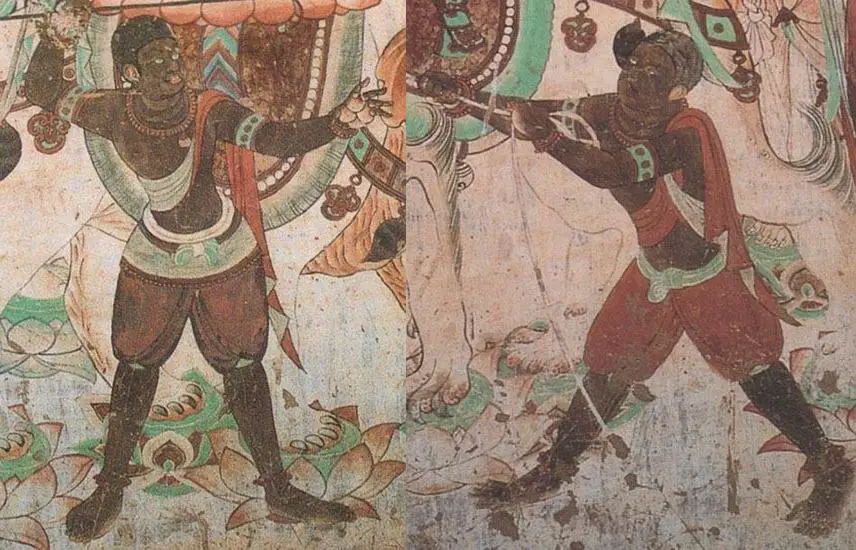 ot all stories tell of outstanding achievements. Not all stories are about role models. And not all stories are stories you want to know. Yet all stories need to be told. And if you pay close attention, you may stumble upon something truly remarkable that sheds light on the darkness, if only for a while.
ot all stories tell of outstanding achievements. Not all stories are about role models. And not all stories are stories you want to know. Yet all stories need to be told. And if you pay close attention, you may stumble upon something truly remarkable that sheds light on the darkness, if only for a while.
The Indo-Pacific slave route dates back to the 9th century when Arab merchants brought African slaves as personal property to Chinese port cities like Guangzhou, known for its large Arab community. The sophisticated, organized and structured Chinese society, suffering from a deep sense of cultural superiority, saw the brutal Arab treatment of African slaves and soon wanted to enjoy the same benefits of exploitation, humiliation, and dehumanization of another race.
On the one hand, Africans were recognized for their enormous physical strength and resilience and were used for hard labor and as doormen, guards, and soldiers; on the other hand, the Chinese saw them as primitive, savage, and lacking human qualities because Africans couldn’t speak Chinese (or Arabic for that matter) and because they were forcibly torn from nature and brought into a sophisticated urban Chinese environment where they lacked means, conditions, and support to adapt.
Their dark skin color contributed to the Chinese associating them with inferiority and black, devilish spirits, who were portrayed in the literature of the early Song and Tang dynasties as magical, superhuman “Kunlun“, which initially stood for dark-skinned Chinese and expanded over time to include several meanings, all having to do with dark skin.
China is still a racist society that hides behind the official party narrative
The fact that there is no official record of the lives of African slaves in Chinese history, which has long kept records of all incidents, especially the extraordinary ones, shows the extent of Chinese mistreatment and misunderstanding towards Africans. And the fact that nothing has changed in the treatment of dark-skinned people in China to this day shows how brutal it must have been to become a slave to a Chinese owner.
The only historical records we have are contracts and travel permits in Chinese, which were kept in the city of Turfan on the Silk Road in what is now Xinjiang. Central Asian traders and Tang elites bought, sold, and traveled with people bearing Chinese and foreign names, because the legal ban on enslaving free Tang subjects allowed for the alternative importation of foreign slaves.
Many works of fiction from the Tang dynasty (618 to 907 AD) deal with the Kunlun, making up for the lack of official documents on the subject, probably due to the little importance the Chinese attached to African slaves, who had no place in the highly structured Confucianist society and were de facto aliens in every sense, just as they were in 18th and 19th century American literature.
In some of these fictional works, the Kunlun is depicted as having supernatural powers, while in others they are described as any other slave. “The Kunlun Slave”, written in 880 CE by Pei Xing, is a famous romance novel in China whose hero is a loyal Kunlun who uses his supernatural powers to rescue his master’s mistress from the harem of a court official.
The plot of The Kunlun Slave
Set during the Dali reign (766-80) of Emperor Taizong, the story is about a young man named Cui who orders his black slave Mo-le to free his mistress, who has been forced to join the harem of a court official. Mo-le undertakes a rescue mission at midnight, kills the guard dogs, takes Ts’ui on his strong black back, and quickly and elegantly climbs to the tops of the walls, where he begins to jump from roof to roof until he brings Ts’ui to his master Cui.
But now both lovers jump onto Mo-le’s back and like a superhero, he leaps over ten high walls and brings his masters to freedom where they will can happily and in peace. Mo-le’s rescue is so heroic and incredible that the girl’s guardian suspects she has been kidnapped by armed knights and decides not to pursue her for fear of endangering his own life.
Two years later one of the official’s servants sees the girl in town and reports her. The official arrests Ts’ui and, having heard the whole story, sends men out to capture the Kunlun. But Mo-le escapes with his only possession, the dagger, and flees over the city walls to avoid capture.
More than ten years later, Mo-le is seen selling medicine in the city without having aged a day.
History is clueless as to the proper proportions of the African role in closed Chinese society
Thanks to their supernatural abilities, the Kunluns were quite frequently represented in fictional narratives such as the Tang Compendium Taiping Guang Ji (Detailed Accounts of the Reign of Great Tranquillity) and in non-fictional works by Song, Zhu Yu. Some historians believe that their magical, supernatural depictions were influenced by the sales tales of Arab traders, although there is not enough data to support this or any other theory.
The general consensus of historians is that prior to the Muslim admiral Zheng He’s expeditions to Africa in the 15th century, there were only isolated instances of direct contact with African culture, which was so different and fascinating to any non-African that the sad truth is that the whole planet eventually exploited Africans.
In any case, we are sure that Africans have been part of Chinese society since the Tang Dynasty as Kunlun slaves, influencing many myths, fairy tales, and legends that show that they were not seen as equal and respected strangers of another culture, but as something supernatural, dangerous and special.
We should not forget, however, that slavery has indeed not yet been abolished in China. Ethnic minorities there are routinely imprisoned and forced into forced labor, for example in cotton fields and in the factories of global companies. So if you think AI is bad, consider that slavery will not end until AI has taken over the entire industry of hard labor, so to speak.

Writer and director who thinks different and does everything differently. Art enthusiast. Wandering and wondering. Until the end of meaning.
irena_curik@hotmail.com





